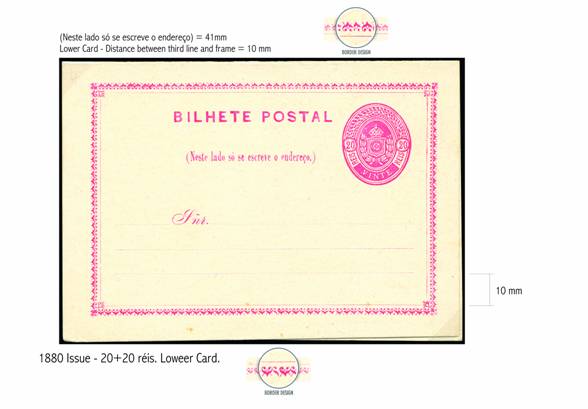|
|
|
Articles |
||||||||||||||||||||||||||||||
|
The 20 reis postcard – Coat of Arms in an Oval Frame. By Reinaldo E. Macedo The 20 reis postal stationeries in crimson: Coat of Arms in an oval frame was created by the Brazilian decree 7841, October 6th 1880. The postal stationeries, specially the 20 reis had an objective: abbreviate the really necessary correspondence and be effective regarding the lead-time. It is possible to observe by text analysis, the effectiveness and certainness of the services, because the messages were regarding visits, meetings, etc for the same day as they were posted. As these stationeries didn't provide any privacy (they could be read by anyone handling it) they were hard to be accepted by the population despite the significant price difference when compared to the conventional system. Simple stationeries (20 reis) (fig 1 and 2) and double stationeries (20 + 20 reis – reply postcard) (fig 3, 4, 5, 6 and 7) were emitted. Printed by the "Casa da Moeda do Brasil" in white/ cream card board of 200g/cm³ standard. There are postcards with different weights. The simple postcard may be found, according to H. Ponge- June/1974, in two formats: a) 117-119 x 81-85 mm and b) 121-131 x 85-89 mm.
|
||||||||||||||||||||||||||||||
 |
||||||||||||||||||||||||||||||
|
Figure 1. Single Postal Card. Type Ia |
||||||||||||||||||||||||||||||
 |
||||||||||||||||||||||||||||||
|
Figure 2. Single Postal Card. Type IIa |
||||||||||||||||||||||||||||||
 |
||||||||||||||||||||||||||||||
|
Figure 3. Double Postal Card. Type I. Upper Card. |
||||||||||||||||||||||||||||||
 |
||||||||||||||||||||||||||||||
|
Figure 4. Double Postal Card. Type A. |
||||||||||||||||||||||||||||||
 |
||||||||||||||||||||||||||||||
|
Figure 5. Double Postal Card. Type II. Upper Card. |
||||||||||||||||||||||||||||||
 |
||||||||||||||||||||||||||||||
|
Figure 6. Double Postal Card. Type II. Lower Card. Up rated with 60 reis to complete the UPU postage (80 reis). |
||||||||||||||||||||||||||||||
 |
||||||||||||||||||||||||||||||
|
Figure 7. Double Postal Card. Type II. The only used joined message and reply card reported. |
||||||||||||||||||||||||||||||
|
There aren't double postcards with the indication of "message" and "reply". As they were correctly separated, there are no forms to differentiate the message and reply postcard and the simple one. According to studies that I have performed, this difference may be seen when we consider – Single Postcard: a) the text (Neste lado só se escreve o endereço) it's 41 mm long, b) the distance of third line to the frame is of 9 or 10 mm and c) the broken icons position on the frame is according to the presented in fig 1 and 2. Double Postcard: a) the text (Neste lado só se escreve o endereço) is 40-41 mm long, b) the third line distance from the frame is 9 mm for the message and 10 mm for the reply and c) the broken icons position on the frame is according to the presented in figure 4, 5 and 6 The 20 reis postcard corresponds to the urban posting, this is inside the town. However if it was complemented with the necessary postage requirements, it could circulate aboard: National territory (between two cities): 40 reis (20 reis for the postcard and 20 reis more for the stamp) and International: 80 reis (20 reis for the postcard and 60 reis more for the stamp) (fig 5). According to H. Ponge - June/1974, the re printing exists and it is characterized by the existence of a fourth elliptic line on the Coat of Arms. This matter must still be analyzed as the wearing of the "plate" may provoke the dismembering of the "lacy" that involves the arms, generating the 4th line characteristic of the reprinting noticed by Ponge. I do not have any study on the material sufficiently concrete. There is an essay of the 20 reis postcard in wine color: the Coat of Arms in rectangular frame (Standard adopted for the 80 reis postcard). On the left low corner, under the frame, there is the indication of Essay. (fig 8) The postcards of 20 reis were demonetized (simple and double) on April 1st 1889, by the publication of December 12th 1888. |
||||||||||||||||||||||||||||||
 |
||||||||||||||||||||||||||||||
|
Figure 8. Essay. |
||||||||||||||||||||||||||||||